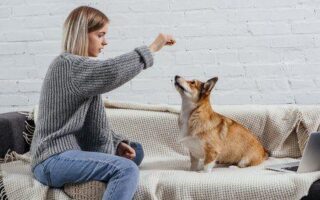Unlocking the Canine Mind: A Journey Through Dog Training Techniques
For centuries, the bond between humans and dogs has flourished, fueled by mutual affection and an intrinsic desire to understand one another. As our loyal companions, dogs have the remarkable ability to reflect their owners’ energy, emotions, and intentions. However, the complexity of this relationship often calls for guidance, particularly when it comes to training. With a myriad of techniques available, from positive reinforcement to clicker training, finding the right approach can feel like an overwhelming task. This article embarks on a journey through the diverse landscape of dog training methods, exploring the philosophies behind them and offering insights into how each can help foster a harmonious connection between humans and their furry friends. Whether you’re a seasoned trainer or a new dog owner, understanding these techniques is the key to unlocking the potential within every pup. Join us as we delve into the art and science of dog training, revealing the pathways to effective communication and companionship.
Table of Contents
- Understanding the Foundations of Effective Dog Training
- Positive Reinforcement: Building Trust and Encouragement
- Exploring Clicker Training for Precision and Clarity
- Addressing Behavioral Challenges with Consistency and Patience
- Q&A
- Closing Remarks
Understanding the Foundations of Effective Dog Training
At the heart of successful dog training lies a solid understanding of canine psychology and behavior. Recognizing that each dog is unique is paramount; their personalities, backgrounds, and even breeds influence their learning processes. Before embarking on any training regimen, it’s essential to establish a foundation built upon trust and mutual respect. Effective dog training can be summarized by several core principles:
- Consistency: Using the same commands and cues ensures that your dog can grasp what is expected.
- Positive Reinforcement: Rewarding desired behaviors encourages dogs to repeat those actions.
- Patience: Dogs learn at their own pace; rushing the process can lead to confusion and frustration.
- Clear Communication: Simple, distinct commands help dogs understand their training language.
Integrating various training techniques can further enhance your dog’s learning experience. The effectiveness of these methodologies can be visually represented in a comprehensive table:
| Training Technique | Description | Best For |
|---|---|---|
| Clicker Training | Uses a sound to mark the exact moment a dog performs a desired behavior. | All dogs, especially those who respond well to sound |
| Leash Training | Teaches walking calmly on a leash without pulling. | Dogs that pull or lunge during walks |
| Obedience School | Formal classes that teach basic commands and socialization. | New puppies and dogs needing social discipline |
Positive Reinforcement: Building Trust and Encouragement
Positive reinforcement is a powerful tool in dog training, helping to create a bond of trust between the handler and the dog. By rewarding good behavior with treats, praise, or playtime, dogs learn to associate these feelings of happiness with their actions. This approach not only enhances their understanding of desired behaviors but also fosters a safe and loving environment where they feel encouraged to explore and learn. Key components of successful positive reinforcement include:
- Consistency: Establish a routine of rewards to reinforce learning.
- Timing: Immediate rewards are essential to help dogs connect actions with outcomes.
- Variety: Use different types of rewards to maintain interest and motivation.
Furthermore, focusing on positive reinforcement builds a culture of encouragement that can be beneficial beyond basic training. This method promotes self-confidence in dogs, allowing them to take risks and engage more fully with their training sessions. As a result, the bond between the dog and trainer deepens. To illustrate the effectiveness of different reinforcement methods, consider the following table:
| Reinforcement Method | Benefits |
|---|---|
| Treats | Highly motivating and easy to use. |
| Praise | Strengthens the emotional bond and provides social reinforcement. |
| Playtime | Encourages a fun learning atmosphere and enhances engagement. |
Exploring Clicker Training for Precision and Clarity
Clicker training is gaining traction among dog enthusiasts for its remarkable effectiveness in teaching various behaviors with precision. This technique leverages a distinctive sound from the clicker to reinforce desired actions, creating a clear communication channel between the trainer and the dog. By associating the clicker sound with rewards, dogs quickly learn to connect their behavior with positive outcomes. Consistent timing and clarity are crucial; trainers must always click at the exact moment the dog performs the desired behavior to maximize understanding and retention.
When incorporating clicker training into your regimen, consider the following key elements to ensure success:
- Start with Simple Commands: Begin with basic commands like sit or down before progressing to more complex tasks.
- Use High-Value Treats: Choose treats that your dog finds irresistible to maintain motivation.
- Keep Sessions Short: Limit training sessions to 5-10 minutes to keep your dog engaged and prevent frustration.
- Practice Regularly: Consistency is essential; practice daily for optimal outcomes.
| Training Element | Description |
|---|---|
| Clicker | Small handheld device that makes a distinct clicking sound. |
| Rewards | Food treats, toys, or affection used to encourage behaviors. |
| Repetition | Regular practice leads to a better understanding of commands. |
Addressing Behavioral Challenges with Consistency and Patience
When it comes to addressing behavioral challenges in dogs, consistency and patience are the cornerstones of effective training. Dogs thrive on routine, and implementing a uniform approach allows them to understand what is expected of them. Establishing clear rules and commands is essential, as is the consistent application of these guidelines. A well-structured training schedule can help reinforce good behaviors and minimize negative reactions. Consider the following strategies to create a stronger framework:
- Positive Reinforcement: Reward desirable behaviors with treats or praise.
- Set Clear Boundaries: Define what is acceptable and what is not.
- Training Sessions: Schedule regular, short training sessions to maintain focus.
Throughout this process, patience is equally crucial. Dogs may not learn at the same pace, and recognizing that every dog is unique fosters an understanding of their individual needs. Allowing ample time for your dog to process commands and expectations can prevent frustration for both trainer and pet. A few strategies to maintain patience include:
- Celebrate Small Wins: Acknowledge improvements, no matter how minor.
- Stay Calm: Your demeanor can influence your dog’s behavior significantly.
- Take Breaks: If things become overwhelming, pause and resume later.
Q&A
Q&A: Understanding Dog Training Techniques
Q: What are the most common dog training techniques?
A: The most common techniques include positive reinforcement, clicker training, leash training, and the “alpha” method. Positive reinforcement focuses on rewarding good behavior, while clicker training uses a device to mark desired behaviors with a sound. Leash training emphasizes teaching your dog to walk calmly on a leash, and the ”alpha” method relies on establishing dominance through specific commands and body language.
Q: How does positive reinforcement work?
A: Positive reinforcement operates on the principle of rewarding desired behaviors to encourage repetition. This can involve treats, praise, or toys whenever your dog obeys a command or exhibits good behavior. The key is to provide reinforcement immediately after the desired action, so the dog associates the behavior with the reward.
Q: Is clicker training effective for all dogs?
A: Clicker training is designed to be effective for dogs of varying temperaments and ages. It creates a clear communication channel between you and your dog, marking desired behaviors with a distinct sound. However, some dogs may respond better to different methods, so it’s important to observe your dog’s reactions and adapt as needed.
Q: What is leash training, and why is it important?
A: Leash training involves teaching your dog to walk politely beside you without pulling. It is important for safety, as it ensures better control in public spaces and promotes a pleasant walking experience for both you and your dog. Consistency and patience are key in teaching your dog to respect the leash.
Q: Can I use multiple training techniques at once?
A: Absolutely! Many trainers find that a combination of techniques can be the most effective approach. For example, you might use positive reinforcement alongside clicker training to strengthen the communication between you and your dog. Just ensure that the methods you choose are compatible and do not confuse your dog.
Q: What should I consider before starting dog training?
A: Before starting dog training, consider your dog’s age, breed, personality, and any specific behavioral issues. Additionally, think about your training environment, schedule, and whether you prefer professional guidance or DIY training. Being consistent and patient, regardless of the chosen technique, is crucial for success.
Q: How long will it take to see results from training?
A: The timeline for seeing results can vary significantly based on the dog, the training method, and the consistency of practice. Some dogs may pick up new commands in a few sessions, while others may take weeks or longer to master certain behaviors. Progress is best measured in small increments rather than immediate transformation.
Q: What role does socialization play in training?
A: Socialization is a vital part of a dog’s training journey, exposing them to different people, environments, and situations. Early socialization helps prevent behavioral issues and fosters a well-rounded personality. Integrating socialization into your training sessions can greatly enhance your dog’s adaptability and comfort in various settings.
Q: What if my dog doesn’t respond to training?
A: If your dog isn’t responding, it may be beneficial to reassess your techniques and approach. Ensure you are being consistent and using appropriate rewards. Sometimes, seeking the help of a professional trainer can provide you with additional strategies tailored to your dog’s specific needs. It’s important to remember that every dog is unique, and patience is essential.
Q: What are some resources for learning about dog training?
A: There are numerous resources available, including books, reputable online courses, and videos featuring expert trainers. Local training classes or dog behaviorists can also provide personalized instruction and support. Engaging with local dog training clubs or forums may offer practical advice from fellow dog owners who’ve had similar experiences.
This Q&A is designed to provide you with a comprehensive understanding of dog training techniques, helping you navigate the rewarding journey of teaching your furry friend. Remember, the key to successful training lies in patience, consistency, and the enduring bond you create with your dog.
Closing Remarks
As we conclude our exploration of dog training techniques, it’s vital to remember that every journey with our four-legged companions is unique. Whether you lean towards positive reinforcement, clicker training, or other methods, the essence lies in the bond you cultivate with your dog. Training is not merely about commands and obedience; it’s about communication, understanding, and mutual respect.
As you embark on your training adventure, be patient and observant, celebrate small victories, and embrace the occasional setbacks as part of the learning process. Ultimately, the goal is to forge a harmonious relationship where both you and your dog thrive together. With dedication and a heart full of kindness, you can transform training sessions into rewarding experiences, paving the way for a joyful and well-behaved companion by your side. Happy training!



